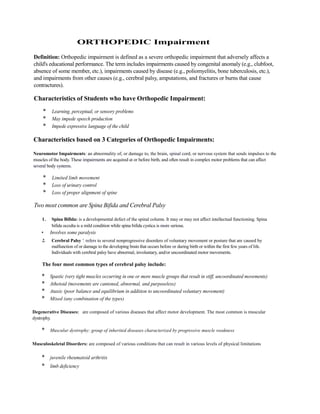
Orthopedic impairment
- 1. ORTHOPEDIC Impairment Definition: Orthopedic impairment is defined as a severe orthopedic impairment that adversely affects a child's educational performance. The term includes impairments caused by congenital anomaly (e.g., clubfoot, absence of some member, etc.), impairments caused by disease (e.g., poliomyelitis, bone tuberculosis, etc.), and impairments from other causes (e.g., cerebral palsy, amputations, and fractures or burns that cause contractures). Characteristics of Students who have Orthopedic Impairment: * Learning, perceptual, or sensory problems * May impede speech production * Impede expressive language of the child Characteristics based on 3 Categories of Orthopedic Impairments: Neuromotor Impairments: an abnormality of, or damage to, the brain, spinal cord, or nervous system that sends impulses to the muscles of the body. These impairments are acquired at or before birth, and often result in complex motor problems that can affect several body systems. * Limited limb movement * Loss of urinary control * Loss of proper alignment of spine Two most common are Spina Bifida and Cerebral Palsy 1. Spina Bifida: is a developmental defect of the spinal column. It may or may not affect intellectual functioning. Spina bifida occulta is a mild condition while spina bifida cystica is more serious. • Involves some paralysis 2. Cerebral Palsy '. refers to several nonprogressive disorders of voluntary movement or posture that are caused by malfunction of or damage to the developing brain that occurs before or during birth or within the first few years of life. Individuals with cerebral palsy have abnormal, involuntary, and/or uncoordinated motor movements. The four most common types of cerebral palsy include: * Spastic (very tight muscles occurring in one or more muscle groups that result in stiff, uncoordinated movements) * Athetoid (movements are cantoned, abnormal, and purposeless) * Ataxic (poor balance and equilibrium in addition to uncoordinated voluntary movement) * Mixed (any combination of the types) Degenerative Diseases: are composed of various diseases that affect motor development. The most common is muscular dystrophy. * Muscular dystrophy: group of inherited diseases characterized by progressive muscle weakness Musculoskeletal Disorders: are composed of various conditions that can result in various levels of physical limitations * juvenile rheumatoid arthritis * limb deficiency
- 2. Teaching Tips * Special seating arrangements to develop useful posture and movements * Instruction focused on development of gross and fine motor skills * Securing suitable augmentative communication and other assistive devices * Awareness of medical condition and its effect on the student (such as getting tired quickly) * Educate everyone in the school community on a student's disability * Have parent/student/resource staff conferences to ensure classroom is accommodating for each child's IEP Due to the various levels of severity of orthopedic impairment, multiple types of assistive technology may be used * speech recognition software * screen reading software * augmentative and alternative communication devices (such as communication boards) * academic software packages for students with disabilities Learning Tools * Physical Therapists who work on gross motor skills (focusing on the legs, back, neck and torso) * Occupational Therapists who work on fine motor skills (focusing on the arms and hands as well as daily living activities such as dressing and bathing) * Speech-Language Pathologists who work with the student on problems with speech and language * Adapted Physical Education Teachers, who are specially trained PE teachers who work along with the OT and PT to develop an exercise program to help students with disabilities * Other Therapists (Massage Therapists, Music Therapists, etc.) Additional Resources * Project Ideal: http: // w w w.projectidealonline.org/orthopediclmpairments.php * Bright Hub Education: http://www.brighthubeducation.com * National Center on Accessible Instructional Materials http://aim.cast.org/learn/disabilityspecific/physical * United Cerebral Palsy: http://www.ucp.org/